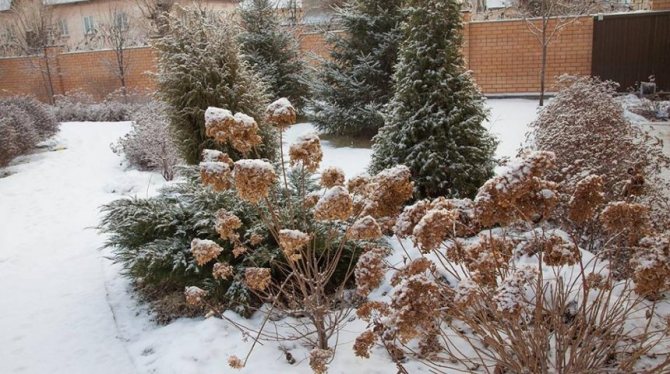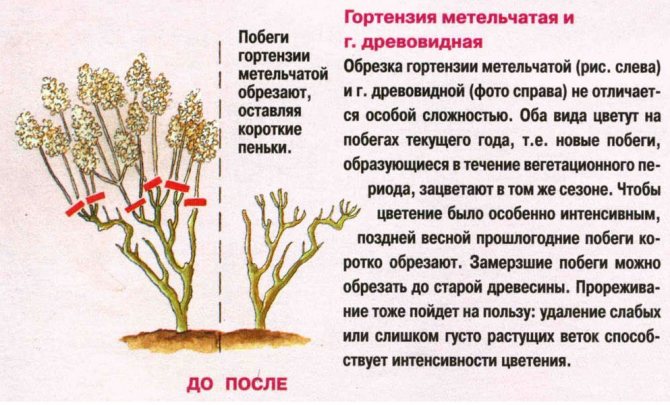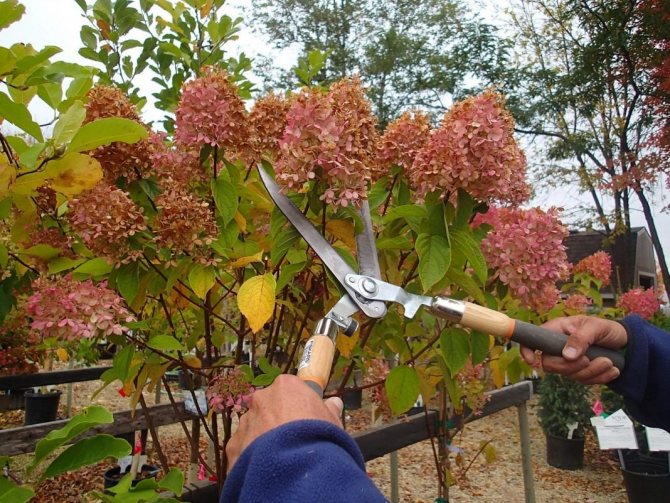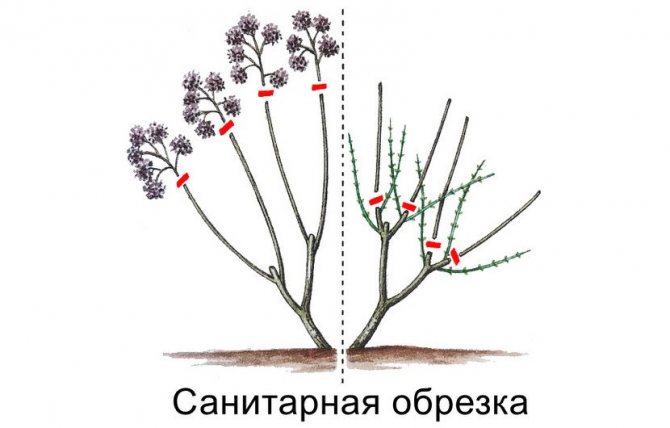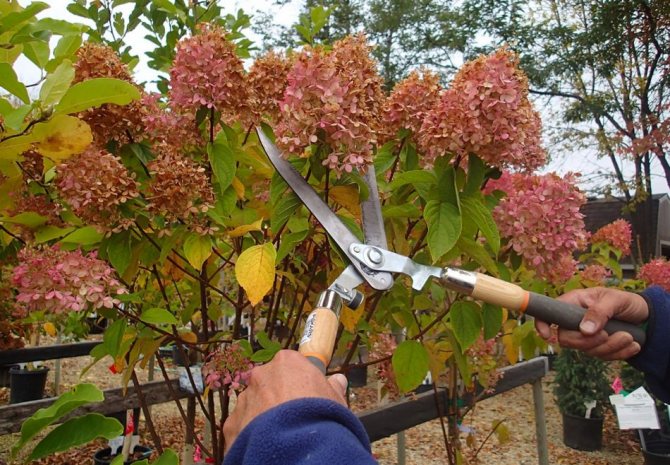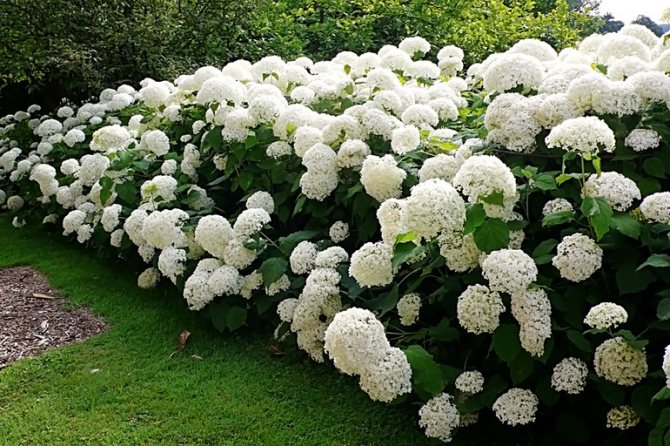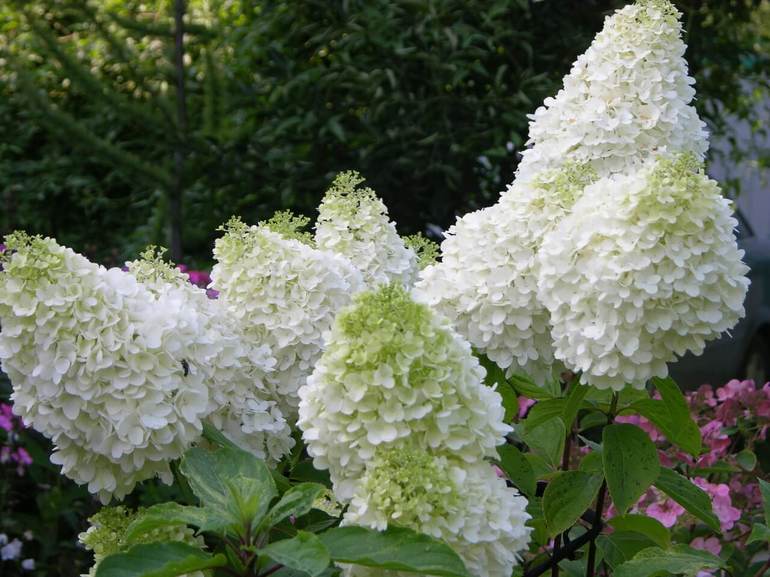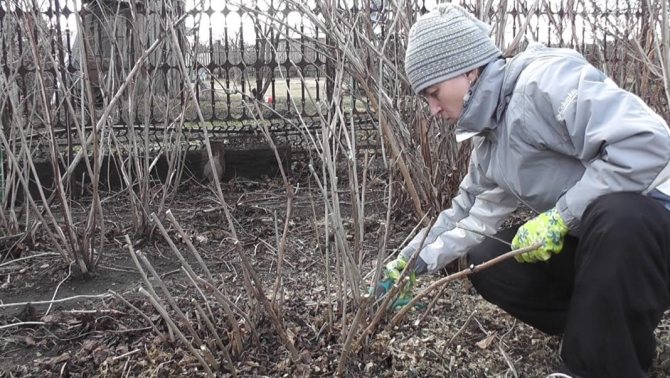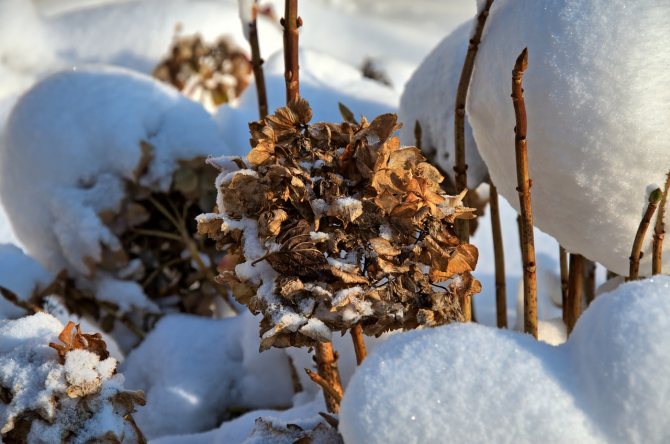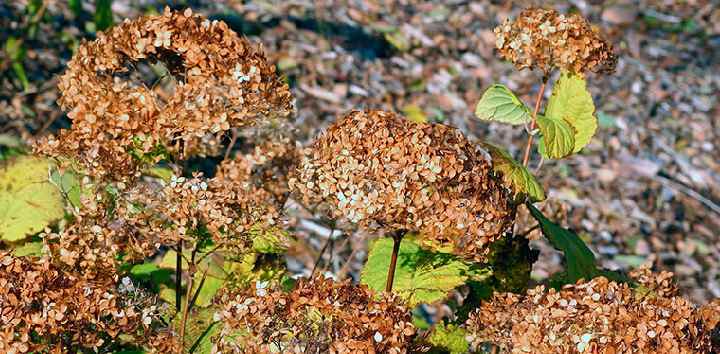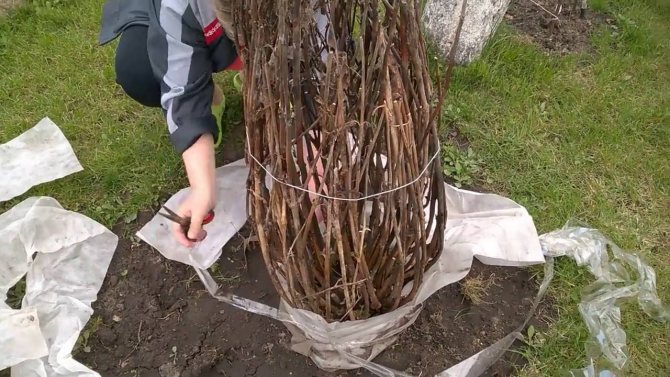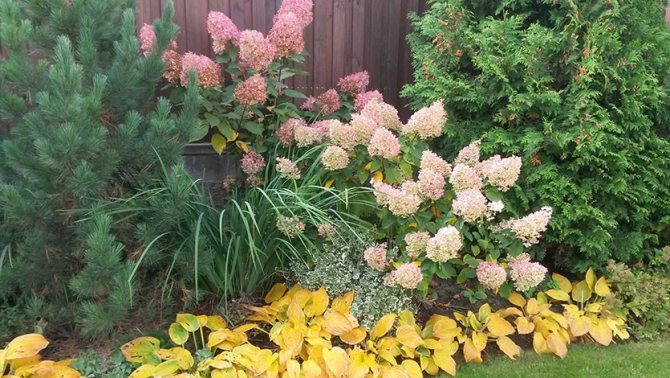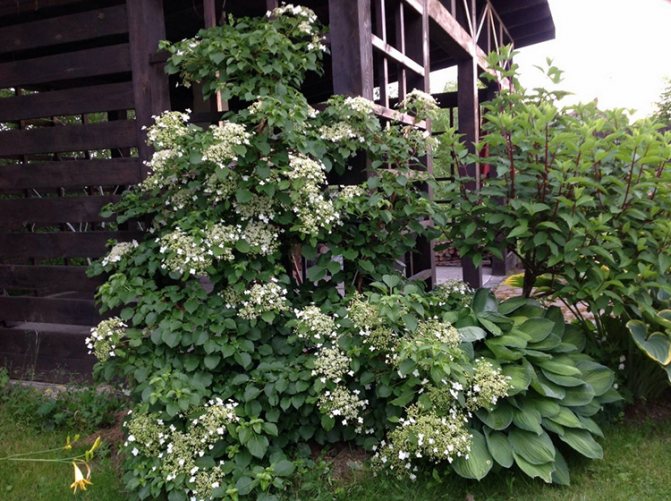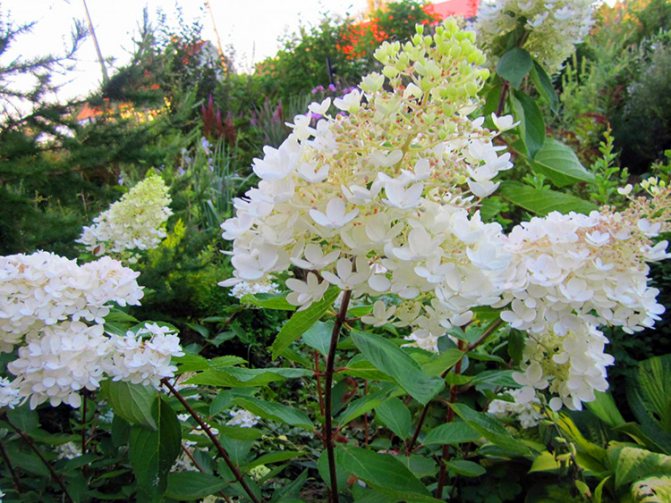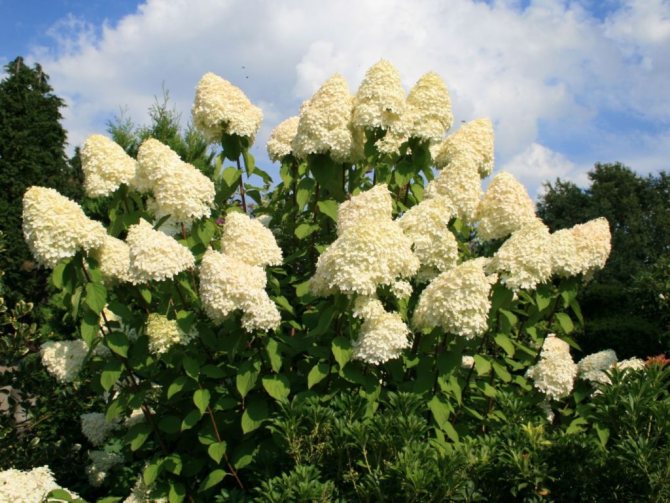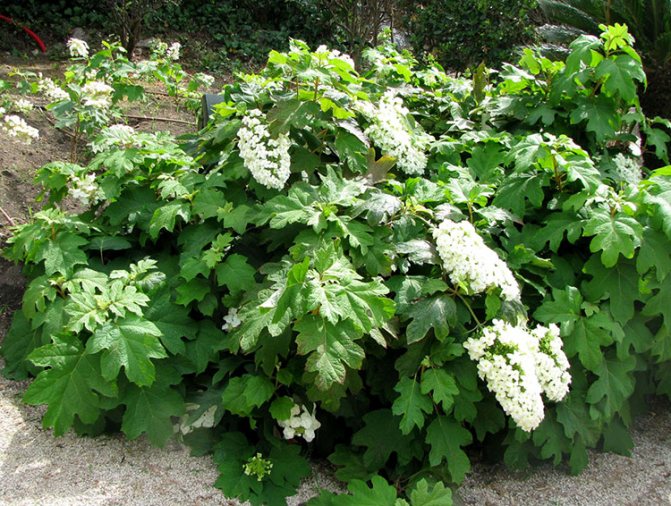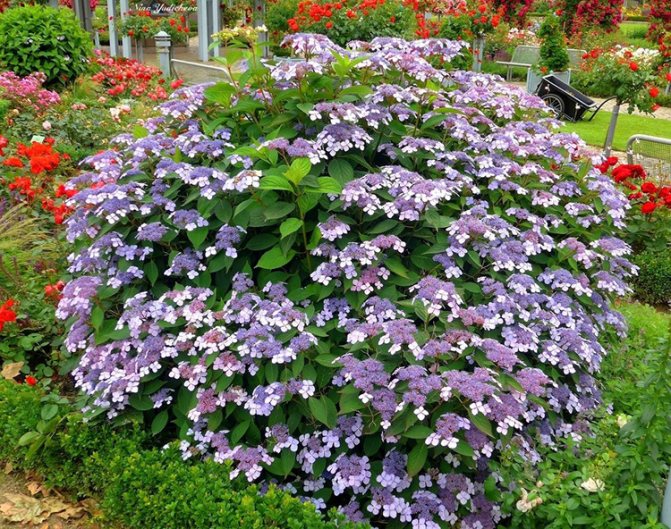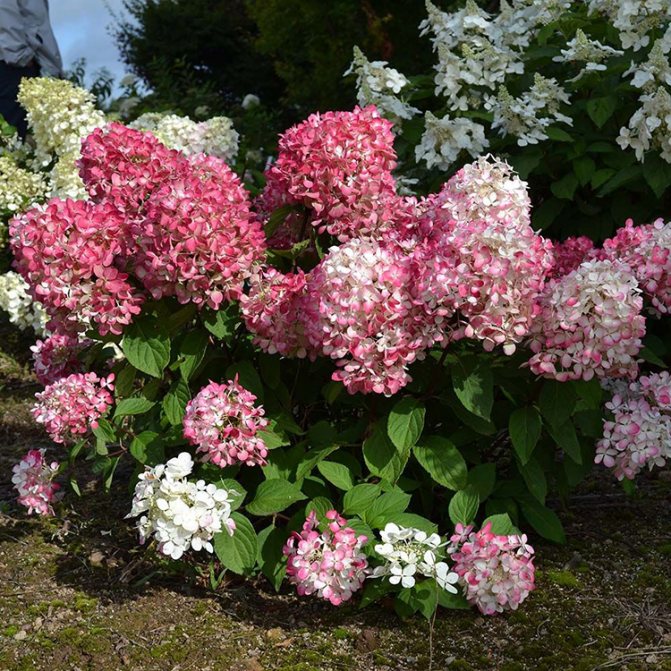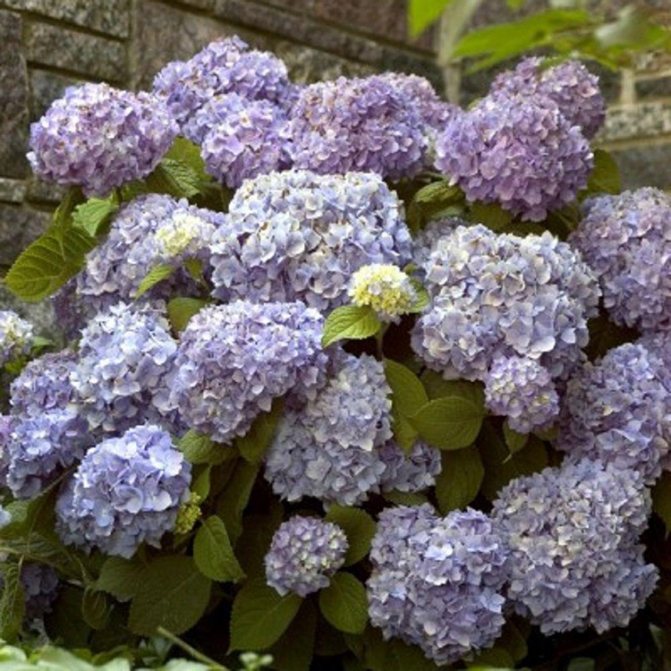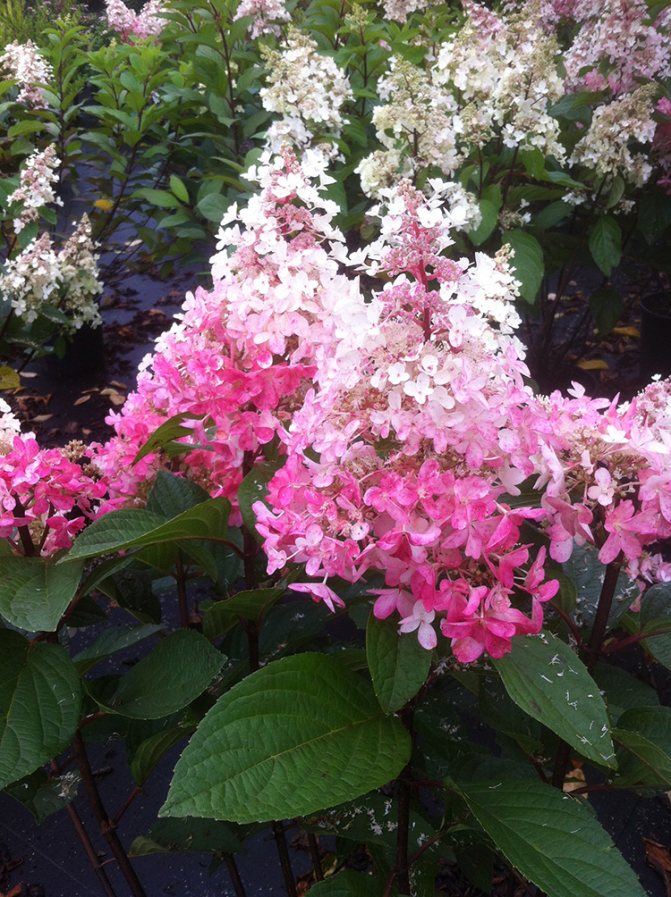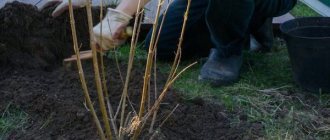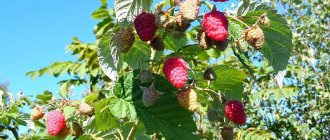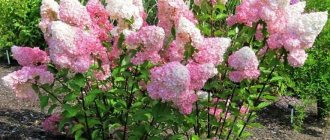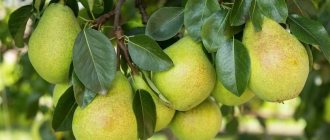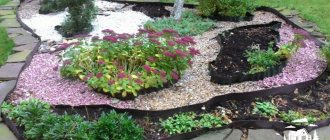One of the most important autumn care operations for hydrangea is shrub trimming. Removing weak and damaged branches, forming the crown, will help the plant to successfully overwinter and please the next year with lush flowering. The general rules for pruning hydrangeas in the fall (tree, paniculate, large-leaved) are described in this article.
Hydrangea is an evergreen or deciduous (the most common variety in gardens) shrub that can reach over 3 m in height and 2.5 m in diameter. With the onset of summer and until the first frost, the plant is covered with large caps of inflorescences of a white, pinkish or blue hue.
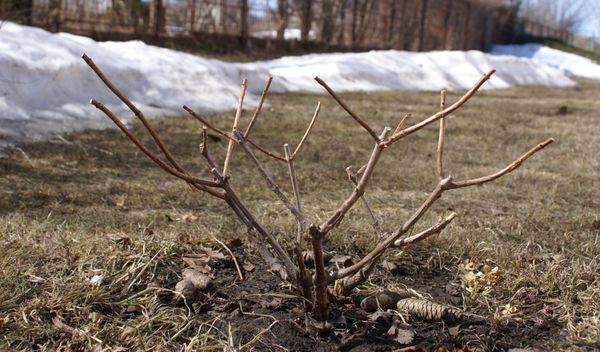
Hydrangea is considered a difficult plant to care for, as it is demanding on soil acidity and watering. The shrub is planted on soils with an acid reaction, achieving the desired effect by adding peat to the soil and mulching the plantings with spruce needles. Citric acid is periodically added to the irrigation water (1 g per 1 liter).
Why do you need pruning?
If the plant is not trimmed annually, over time, the bush will become too thick. Sunlight will not be able to penetrate deep into the crown, the foliage will begin to shrink, the damaged and old branches will dry out, and parasites can settle on them. An unformed hydrangea looks sloppy.
Do I need to prune my hydrangea for the winter?
Whether or not to cut the hydrangea is not a difficult question, for this you need to find out to which frost resistance zone the planted variety in the garden belongs. It is known from history that the plant was previously grown as an indoor plant and it came from warm Eastern countries.
But, thanks to breeding work, new varieties are fully surviving the winters of the Middle Belt, and some even in Siberia and the Urals. In the southern regions, pruning should be done only for rejuvenation and crown formation.
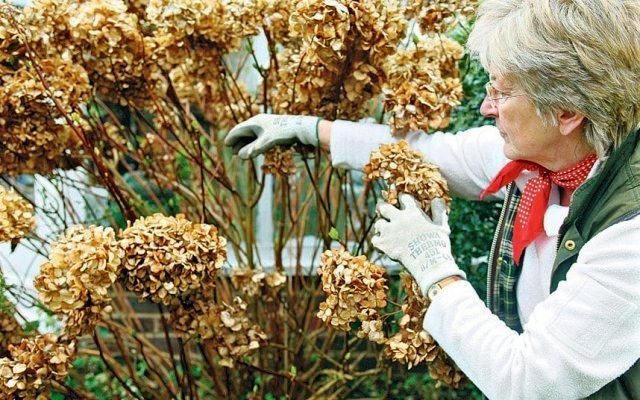

Shelter methods
The shrub tolerates cold well, but if the temperature in your area drops below -35 ° C, then you should use one of the following shelter methods:
- Prepare a plank 25 cm wide and as long as the height of a bush. Drive nails over the entire surface. Place it on the surface of the ground. Tie the branches with fabric ties and put them on the board. Fix the shoots using a rope. Cover everything with dry foliage, sawdust and pine needles. Wrap the top with spunbond, and then with polyethylene. The foil can be secured by placing stones on the edges.
- The shrub must be wrapped in spunbond. Install the frame around using a metal mesh, keeping a distance of 30 cm. The structure should exceed the plant height by at least 12-15 cm. Pour dry foliage inside. This method is the most popular.
- Cover the circle near the trunk of the bush with pine needles and lay hydrangea shoots on them. Fasten the branches at the center with wire staples. On top, you also need to lay out a layer of spruce branches and spunbond in turn. Cover everything with sawdust and peat, and then again cover with pine needles. And at the very end, cover it with polyethylene to protect it from moisture.
Video: shelter of a young panicle hydrangea for the winter
How to care for hydrangeas in the fall
The composition of the care of hydrangeas in the fall includes the following:
- Eradicating autumn spraying (treatment) from diseases and pests (as an option, you can use a 3% solution of Bordeaux liquid).
- Transfer (but only paniculate or tree-like varieties, it is better to transplant large-leaved varieties in spring).
- Reproduction (by dividing a bush or digging in layers, but cuttings are carried out only in summer).
- Top dressing and watering (more on this later).
- Pruning.
- Shelter for the winter.
Moreover especially important to properly prepare the hydrangea for winter, namely to hold autumn pruning and shelter for the winter.
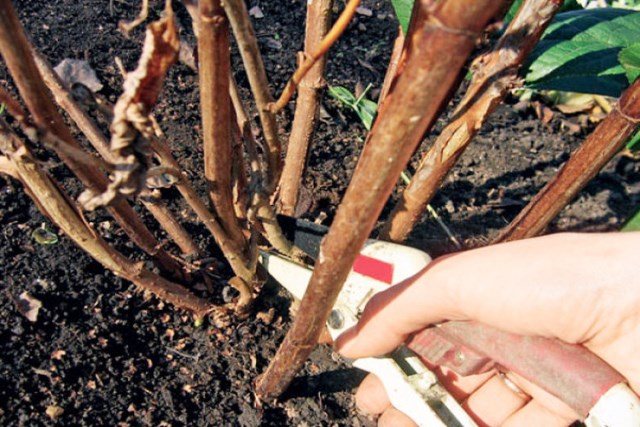

Hydrangea pruning rules


Shrub trimming is carried out in spring and autumn.
- The nature of spring work is to remove frost-damaged shoots, twigs broken by snow. This is called sanitary pruning. It is carried out immediately after the snow melts, before the leaves bloom.
- Autumn haircut consists in crown formation and is aimed at stimulating the plant to create a large number of flower buds. The work is carried out on days when the air temperature during the day has not yet dropped below +7 degrees.
The nature of pruning hydrangeas in the fall differs depending on the variety. Shrub varieties are divided into groups:
- hydrangea that forms flowers on the shoots of the last year (large-leaved hydrangea);
- a plant blooming on annual twigs (paniculate, arboreal, Vanilla Freise).
A common action for all hydrangeas will be to remove damaged shoots and branches that thicken the crown. Old, obsolete branches are cut down at the root.
A useful video about the differences in the types and methods of cropping from the Garden World channel:
Pruning hydrangea paniculata in autumn
After removing all unnecessary branches, they begin to form a bush.
Now read:
- Hydrangea care in the fall. Preparing for winter
- Hydrangea
- Planting hydrangeas outdoors in autumn
- Pruning roses in the fall for beginners, depending on ...
- Hydrangea tree (white) at their summer cottage
- To get a powerful growth of shoots and large inflorescences for the next year, all lateral branches of the plant are cut off, leaving 2 buds.
- 2-3 strong shoots are left on the bush for rejuvenation. Branches older than 4 years old are removed.
Pruning hydrangeas in a tree-like fall, similar to trimming the paniculate variety. Both plants form flowers on young shoots.
Video: pruning panicle hydrangea depending on the variety
Large-leaved hydrangea
The shrub is cut minimally in autumn, removing only faded inflorescences and weak branches thickening the crown.
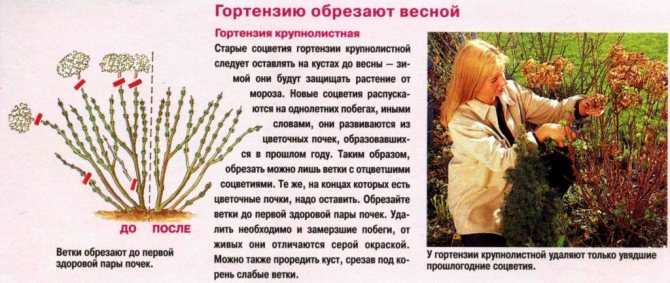

(can be increased)
Important! Garden hydrangea (aka large-leaved) blooms on last year's shoots! Pruning them in the fall will result in no flowering.
The rejuvenation of the shrub is carried out every 3 years, shortening the old branches by 40 cm.
Video: pruning a tree hydrangea
Pruning hydrangeas in the fall for beginners
It can be difficult for a novice gardener to immediately understand the intricacies of pruning a shrub. For convenience, below is a step-by-step scheme for pruning panicle and tree hydrangea (the gardener remembers that only the inflorescences are removed from the large-leaved one).


(can be increased)
Pruning is carried out when the leaves from the plant have already flown. Looking at the bare branches makes it easier to identify excess shoots.
They begin to form a hydrangea from the age of 4.
With a sharp pruner or garden saw, remove:
- old branches (over 4 years old) at the root;
- weak and thin shoots that thicken the crown.
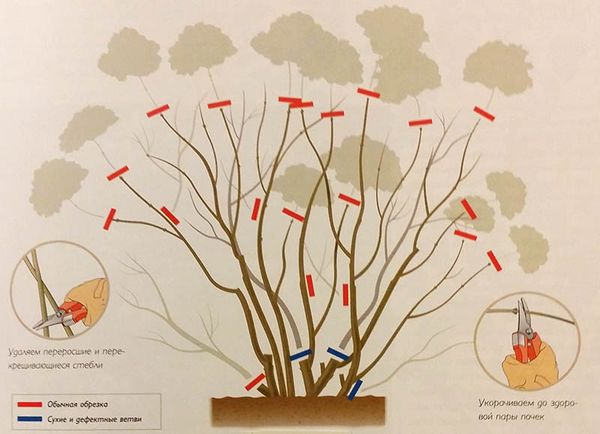

All wounds, after pruning, must be covered with garden varnish or a mixture of clay and manure (if there is no special putty at hand).
Further, on panicle hydrangea, 5-6 strong shoots are chosen, arranged in a fan (at approximately equal distance from each other). They are shortened to 2-4 buds from the base of the bush. The remaining branches are removed without leaving hemp.
Garden hydrangea, if the bush is not thickened, can not be cut.
Autumn feeding of hydrangea and its watering regime
When the hydrangeas finish their flowering, and their buds begin to dry out gradually, it's time for autumn feeding, which should help the shrub to hibernate in a strong state, successfully laying vegetative and flower buds for future growth and flowering in the new year.
In the fall, it is necessary to apply potash-phosphorus fertilizers to the soil, hydrangeas are no exception. During this period, it will be good to feed them with potassium sulfate - as a potassium fertilizer, superphosphate - as a phosphorus fertilizer. Or you can buy ready-made autumn fertilizer.
Remember! No nitrogen fertilizers in the autumn, and no ash as a potash supplement, because it alkalizes the soil, while hydrangeas, on the contrary, need soil-acidifying fertilizing.
But watering in the fall is practically stopped (especially if the weather is cloudy and / or rainy), although, as you know, hydrangea loves moisture very much, so it is very important to water it regularly during hot periods of the year during abundant flowering.
Frost resistance of the plant and wintering features
Various varieties of hydrangea hydrangea are cultivated by flower growers, which grow well in soil with an increased pH reaction:
- large-leaved. A culture with a low level of frost resistance. Flower buds form on last year's shoots. Large-leaved hydrangea needs a reverent attitude in preparation for winter, given that without shelter, the flowering branches will freeze, the bush will not bloom;
- oak-leaved. Hydrangea is afraid of frost, reacts poorly to the wind. When planning to decorate the garden with this beauty, you should select a cozy corner for her away from the prevailing wind directions. For a safe wintering, it is required to cover the bush well;
- Himalayan. The garden flower has high frost resistance properties, the need for shelter arises in exceptional cases;
- tree-like. The culture does not experience discomfort from the effects of severe frosts. After wintering, it is easily restored;
- paniculate. This type of flowering shrub is one of the most frost-resistant, able to withstand temperatures as low as -35 ° C.


Panicle hydrangea
Of great interest among gardeners-florists is the petiolate hydrangea, which stably tolerates low temperatures well and does not need shelter.
Care of young hydrangea
A plant planted in autumn requires particularly careful shelter for the winter. In the first year of life, the seedling must:
- water often (once a week, go 10 days);
- mulch the soil around the bush with peat, pine bark;
- shade from the aggressive midday sun.
A young plant planted in the fall is not fed in the first year, since the fertilizers that are laid in the planting pit are enough for it. Top dressing begins to be given from the second spring from planting.
They take their time with pruning, giving the hydrangea to gain strength and not suffer from the stress of pruning. Cutting the bush begins from the third year of life.
Features of preparing large-leaved hydrangea for winter
Large-leaved varieties of hydrangea are prepared for winter more carefully, since the inflorescences are on the shoots of the previous season. All branches that are 3-4 years old are subject to pruning. The rest of the healthy shoots must not be shortened. The main task of the preparatory period is to fully cover the bush.
Waiting for spring: how to cover a hydrangea for the winter. In a special publication of our portal, we will tell you in detail how to cover a hydrangea for the winter. You will learn the basic technologies for hiding hydrangeas and how to keep a hydrangea in a pot in winter.
Terms of work on the care of hydrangea in the fall
All events are held in a certain weather and climate of a particular area, time.
Depending on the region
In the Central lane and the Moscow region feeding and transplanting hydrangeas is carried out in September so that 40-45 days remain before the onset of cold weather.The shrub is cut in early October, the shelter is prepared at the end of the month
In the Leningrad region autumn is usually rainy and cold. Transplantation, feeding of plants is carried out no later than mid-September. Cut off - at the end of the month. The hydrangea is covered with the arrival of frost - in October.
In the Urals and Siberia the climate is characterized by severe frosts in winter and short, cold autumn. It is not easy to grow a heat-loving perennial here. Work on transplanting, feeding and pruning hydrangeas is carried out in late August - early September. At the end of September, the shrub already needs to be reliably insulated.
On Southour country, hydrangea is not insulated for the winter. Plant transplantation takes place throughout September; perennials can be cut in October and early November.
Features of pruning and preparing for winter paniculate and tree hydrangea
Pruning of these varieties is similar and is carried out in several stages. First, the entire bush is carefully examined and all damaged branches and old shoots are removed if your hydrangea is more than 5 years old. The shoots of the last year are shortened by 6-7 buds, and the branches on which there were no inflorescences, removed completely.


Pruning weak shoots directed into the bush and removing all inflorescences
In order for the plant to quickly gain strength after spring, it must successfully overwinter. As a preparation measure, you need to remove the leaves from the bush, and insulate its base with dry grass. The plant is covered in a convenient way before the onset of frost.
Treatment of plants from pests and diseases
This procedure is carried out in order to destroy the spores of fungi and pests that can winter on the bark of a plant and show their negative effect in the spring. Spraying is carried out after leaf fall, on bare branches. Apply at choice:
- Bordeaux mixture in 1% concentration,
- drug Abiga-Peak (40 ml per 10 l of water).
When spraying the crown of a hydrangea, it is necessary to ensure that the solution gets on all parts of the plant, including the surface of the ground around the bush. When working with the solution, you should protect your face with glasses and a mask, be in a headdress and work clothes. After spraying, wash your face and hands with soap and water.
Shelter for the winter of young and adult hydrangea bushes
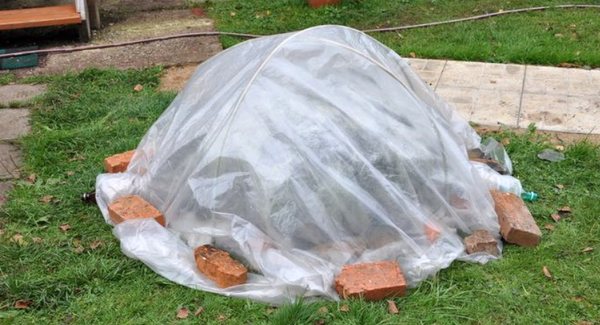

The final step in the list of procedures for preparing hydrangeas for winter. Throughout Russia, except for the south, hydrangea bushes need shelter for the winter. Work is carried out after leaf fall or when the daytime temperature drops to zero marks.
- The surface of the earth around the hydrangea bush is mulched with light and free-flowing material: peat, crushed pine bark, shavings of coniferous trees. The mulch layer is about 20 cm.
- Low perennials and young bushes can be covered with shavings "headlong" or covered with agrotechnical cloth, darnite or spruce branches, fallen leaves.
- Treelike hydrangea is bent to the ground. For this, the branches are pulled together with twine and laid on boards or slate sheets laid on the ground. From above, the crown is pressed with scraps of boards or twine is tied to stakes driven into the ground. A non-woven material, straw, spruce branches are thrown over the plant from above. After a snowfall, they scoop up the snow.
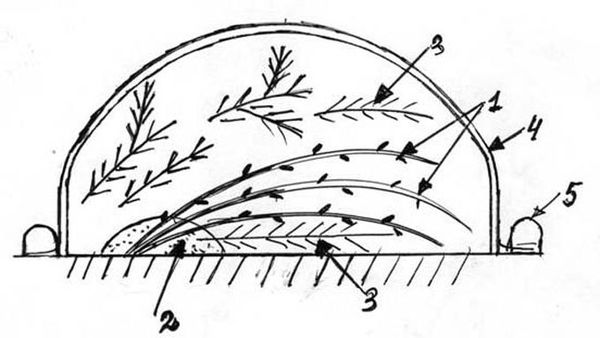

- If the bush is tall and spreading and cannot be tilted without damaging the branches, the hydrangea is insulated in a different way. The crown is pulled together with twine, turning into a cylinder, wrapped in lutrasil, darnit. A net is installed around the plant, surrounding the bush. For strength, stakes are driven into the ground around the mesh. Leaves and straw are stuffed into the free space between the tree and the walls of the net. In such a warm and dry "cocoon", hydrangea will not freeze even in severe frost.
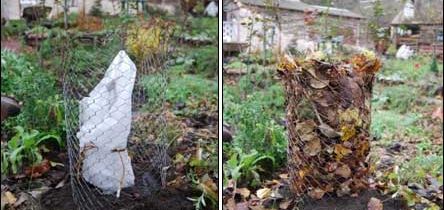

With the arrival of spring heat, you should remove the shelter from the bushes in time, preventing the plant from heating up.
Video: hydrangea shelter for the winter in the middle lane
Transplanting and planting hydrangeas in the fall
The operation can be carried out with all plants, except for the garden hydrangea (large-leaved). This species is thermophilic and capricious, does not tolerate winter cold and does not have time to take root before frost.
- Large-leaved hydrangea is planted only in spring.
- The paniculate and tree-like varieties root well, planted 1-1.5 months before frosty weather sets in.
A site for planting plants is chosen in the lace shade of trees, on the eastern slope of a hill or near a building so that the hydrangea is in the shade during the day. The foliage and flowers of the shrub in the bright midday sun quickly fade and lose their attractiveness. The bush will have to be watered more often.
The soil should be fertile, water-absorbing (but without stagnant water!) And loose. Hydrangea is a plant of acidic soils, neutral and alkaline soils are acidified by the introduction of peat and compost from spruce needles. The compost of spruce or pine needles is prepared as follows: the needles are stored in a shady place, compactly tamped and watered. Compost is ready for use 2 years after setting. A pit for planting a young hydrangea seedling is prepared 50 by 50 cm in size and about 40 cm deep.It is filled with the mixture:
- sod land 2 parts;
- humus 2 parts;
- coarse sand 1 part;
- peat 1 part.
Fertilizers are added to each bucket of such a mixture: 60 g of superphosphate, 20 g of sulfuric potassium.
A hydrangea seedling is placed in the center of the pit and covered with soil so that the root collar is on the surface of the ground. After planting, the bush is abundantly watered and mulched with peat, pine needles or bark.
If an adult hydrangea plant is transplanted, it is dug up along with a clod of earth, trying not to damage the roots. A pit for planting is dug so that an earthen lump is placed in it entirely and there is still a free space of 2-4 cm to the walls of the pit. This space is filled with the above nutrient mixture. It is immersed in the planting hole without burying it in the soil.
The distance between plants depends on the size of an adult bush. A low paniculate variety is placed at a distance of 70-90 cm, a tree-like variety is planted at least 2-2.5 m to other plants.
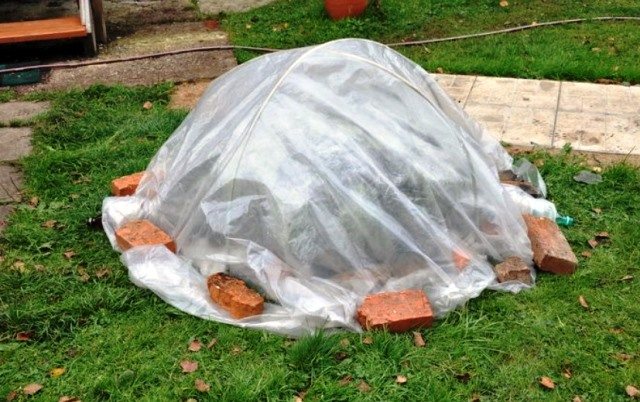

How to feed hydrangea in the fall after pruning
In autumn, the main task of the gardener in caring for a perennial is to prepare the plant for winter. Proper feeding plays an important role in the successful wintering of hydrangeas.
Phosphate-potassium fertilizers are used, which contribute to better maturation of wood and root system.
Attention! Nitrogen fertilizers that promote the growth of green mass must not be applied in autumn!
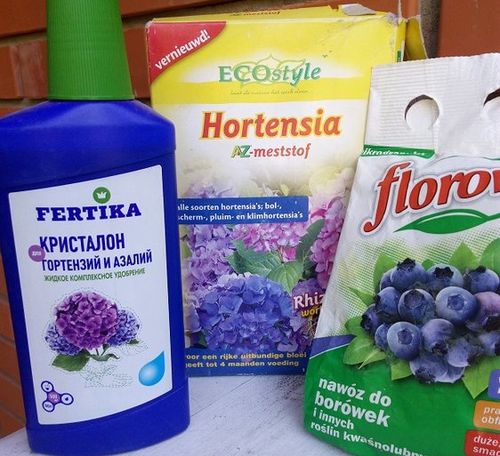

It is convenient for a novice gardener to purchase ready-made complexes of mineral fertilizers, especially for the autumn feeding of hydrangeas. For example:
- Fertika (in liquid form);
- Pocon (fertilizer granules are simply scattered over the soil surface, they gradually dissolve, nourishing the plant).
The specified fertilizers are applied to the soil according to the attached instructions.
If it is impossible to buy a special composition, apply:
- potassium sulfate - 2 tbsp. spoons per 10 liters of water, consuming 5 liters of solution per one bush;
- wood ash - 250 - 300 g is scattered over the soil surface, shallowly loosening the earth.
Immediately after pruning, hydrangeas are not fed in the fall, since the plant is under stress. Fertilization is carried out 12-15 days after pruning. Fertilizers cease to be absorbed by the plant when the air temperature drops below -10 degrees.
It is practiced to mulch the soil surface around the shrub with humus, a layer of 5 cm. Mulch plays the role of insulation for the roots and, in addition, nourishes the plant. In addition to humus, hydrangea is mulched with peat and spruce needles. Gradually decomposing, this mulch acidifies and loosens the soil, which is beneficial for hydrangeas.
It is very useful to shed a bush before wintering with a potassium magnesium solution. This drug includes the following substances: potassium, sulfur and magnesium. It is used to enhance immunity and strengthen the root system before the coming winter.
20 g of potassium magnesium is dissolved in 10 liters of lukewarm water and watered at the root of the plant.
When choosing fertilizers for hydrangeas, it must be borne in mind that the color of the buds directly depends on the predominance of a certain element in the soil.
- Hydrangeas with blue and blue flowers require an acidic soil. In autumn, plants are fed with potassium salfate (30 g per 10 l) and ammonium sulfate (20 g per 10 l). The bushes are mulched with peat and needles.
- Bushes with pink flowers need phosphorus. A complex fertilizer Agricola 2 is suitable for such a hydrangea, with the additional introduction of wood ash (200 g per bush). It is not required to artificially acidify the soil.
- White hydrangea is mulched with humus. Of the mineral fertilizers, superphosphate is used (60 - 80 g per bush).
Is it necessary to cover for the winter
Thus, not all varieties of hydrangea need to be sheltered for the period of cold weather, or rather only tree and paniculate, since they are highly frost-resistant. It will be enough to slightly huddle each of the bushes.
But the large-leaved hydrangea is strongly recommended to be carefully covered for the winter, since it is a very thermophilic species. Therefore, if this shrub is not covered in the middle lane and cold northern regions, then it will definitely not bloom.
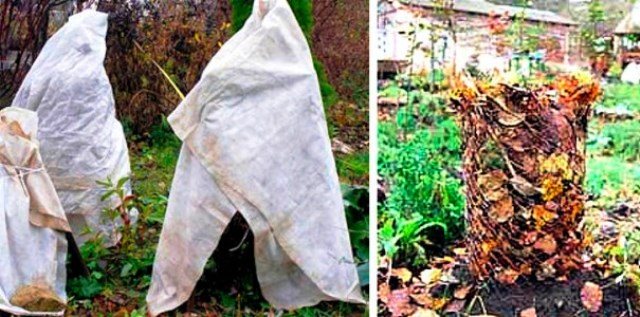

Varieties of hydrangea paniculata, tree-like and large-leaved - names and photos


And here are the lines that the famous poet Andrei Podvolotsky dedicated to the flower: "Hydrangea bloomed in your garden, Such yellow-blue tenderness, Reminding the garden of Eden of Paradise ..."
In fact, there is a lot of paradise in this flower: a fragrant aroma, beautiful buds. According to one version, the name of the flower comes from the Greek words hydor and angeion - a vessel with water, or Hydrangea. According to another, it is believed that the plant was named after a certain lady with a rare name. In any case, the Hortensiev family is large, and we will get acquainted with several popular garden varieties.


The panicle hydrangea represents the Bobo variety. It is a highly awarded dwarf shrub in Belgium. Interestingly, the petals change color from creamy yellow to pinkish
Bobo - great for a container in a slightly shaded area. This kind of wind does not favor.


Another great variety - Vanille Fraise
The giant among panicle hydrangeas Vanilla Fraz reaches 2 m, so this variety is chosen for large gardens. Note the imposing inflorescences reaching 30 cm in diameter.


Grandiflora with pyramidal inflorescences will decorate a shady corner in the garden
Change of color at Grandiflora occurs gradually from white, pink and greenish-red shades. Treelike hydrangea is represented by numerous varieties of shrubs and even vines.


Annabelle spreads its crown wide with never yellowing leaves
Anabel grows up to 1.5 m, and the spreading crown occupies 3 m. The variety pleases with a long flowering and large cream-colored inflorescences.


White Dome is a creamy white variety of panicle hydrangea
A strong bush does not allow inflorescences to fall off in rainy weather. This is the most winter-hardy variety. Large-leaved hydrangea is the most delicate of all, but breeders have already developed a variety with increased winter hardiness - Endless Summer. Endless Summer color change varies in shades of blue.


Endless Summer with ruffled petals


Green Shadows surprises with a reddish shade of inflorescences. The variety got its name because of the green shadows around the edges of the petals.
When to prune hydrangeas in the fall: optimal timing
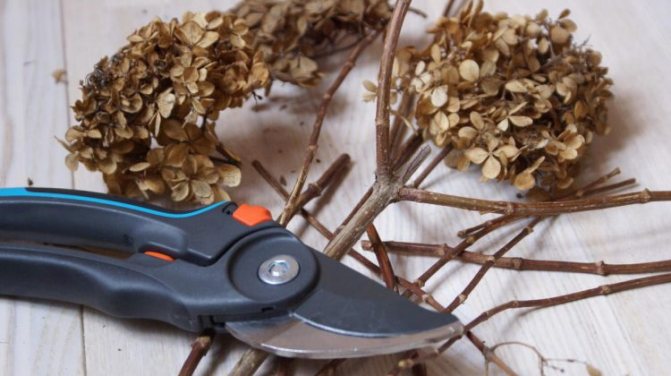

The optimal time for pruning hydrangeas in the fall is the period of persistent cold weather. At this time, all the foliage falls off the plant, and only dried inflorescences remain on the stems. Let's find out what terms this period corresponds to in different regions of Russia:
- Moscow region and middle zone of Russia - late October or early November.
- Southern regions of the country - late November or early December.
- Ural and Siberia - September.
The above terms are determined by experienced gardeners only approximately for beginners. You should not focus only on them. Always take into account the local climate and observe the condition of the plant itself: by the autumn pruning, its foliage should fall.
rules
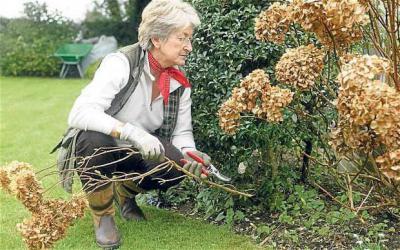

It is very important to systematically and accurately prune all types of hydrangeas. Of course, they will grow well without it, but the bushes will begin to thicken and lose their decorative appeal, and the inflorescences become smaller over time.
It is customary to do the main pruning in the spring, but many gardeners very often do this before frost to strengthen the plant and make it stronger.
Pruning tree hydrangeas in the fall is done like a typical shrub. After sanitation, branches that have faded are transferred to obsolete ones and removed to the ground. This is done in order to enhance the formation of young shoots. After that, small thickening twigs on the main bush are thinned out. Last year's shoulder straps are cut in half, only a few buds need to be left on them, from which young and strong shoots with large inflorescences will begin to grow.
It is necessary to tell for beginners, pruning hydrangeas in paniculate autumn is done like a tree. Its skeletal branches and trunks are quite durable, therefore, rejuvenation is performed by transferring shoulder straps to a young branch. Among the three shoots emerging from one bud, it is necessary to keep 1–2, directed outward. Excess twigs need to be removed, and all last year's should be shortened and only a few pairs of buds left there. The thicker these shoots, the more buds are recommended not to be cut.
Unlike past species, pruning a garden hydrangea in the fall is done differently. In large-leaved and similar types, last year's shoots cannot be shortened, since the main buds for flowering are concentrated at their ends. But this does not mean at all that such plants, in general, should not be cleaned. It is important for them to perform a rejuvenating procedure. Cutting is carried out to the base of the old shoulder straps, which do not allow the young to develop actively. The new sprouts will give full bloom next year. This treatment helps to achieve a balance between flowering and growing shoots, which ensures annual beauty.
Fundamental rules
In Russian gardens, 3 varieties of hydrangeas are most often found. Paniculate appearance has elongated inflorescences, reminiscent of panicles. In the tree type, the brushes are spherical, slightly flattened and large in size. These 2 varieties are also called white. Their flowers are formed on the shoots that have grown in the current year. Such plants do not require shelter for the winter.
Large-leaved specimens have the same ball-shaped inflorescences, but differ from tree-like ones in a denser leaf plate. Their brushes are formed on last year's shoots. For the winter, such a hydrangea must be carefully covered. Given the properties of these types of plants, pruning each of them has its own subtleties.
Panicle hydrangea
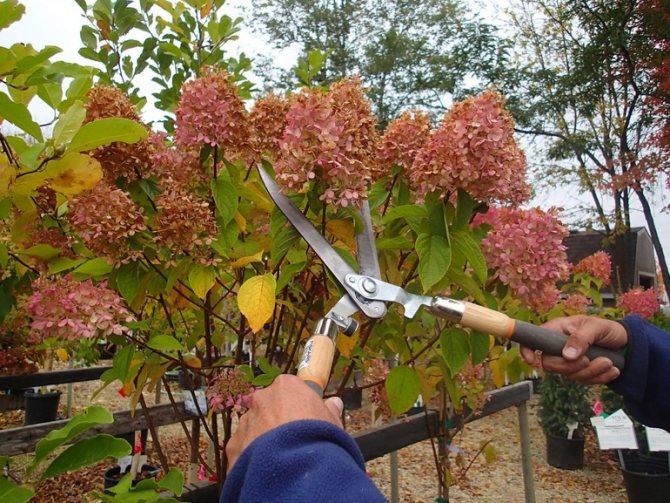

This variety does not need overly active pruning. Branches that grow from one point (they are also called skeletal) should not be touched. Only shoots that have grown incorrectly and are directed crookedly or into the bush are subject to removal. All panicle inflorescences are necessarily cut offthat the flower has released on the shoots of the current season. If you leave them for the winter, young branches may not withstand the weight of the snow and break off.
You need to remove flowers along with part of the branch. Several lower buds are left on it for the next year. If everything is done correctly, next summer such a bush will have a dense lush crown and look neat and well-groomed. This pruning of hydrangea in paniculate autumn is relevant for young specimens.
If the plant has been living on the garden plot for a long time and needs rejuvenation, it is necessary to examine the bush and choose one of the shoots that grow from a common point. This stem should be the strongest and healthiest, pointing outward. All other branches are removed under the spine. With the onset of heat, extinct shoots are removed from the shoot and give the plant a neat shape.
Advice!
You can form and grow this species on a trunk. In this case, the bush will turn out to be miniature and will look more like a decorative bouquet or tree.
Tree varieties


In the first few years after planting, these plants do not need to be pruned. If the rule is not followed, the bush may die. In a young plant, the inflorescences need to be removed after they fade. Without fail, 3 or 4 pairs of buds are left on the stem.
Next year, new young twigs will grow from them and a lush, beautiful crown will form. The cut shrub is carefully wrapped up and left for the winter.
For more mature bushes, carry out pruning for rejuvenation... At the same time, all the stems are removed, you need to leave only hemp no more than 10 cm long. In the coming spring, this will provoke the active growth of young shoots. This type of pruning in the fall of a tree hydrangea is best done in a gentle way. Removal of stems is carried out within 2 or 3 years. Otherwise, there is a risk that the root system will not have enough nutrition and the bush may die.
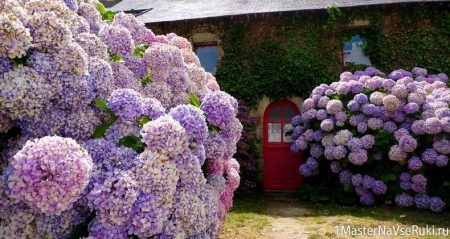

You may be interested in:
How to transplant a hydrangea to a new location in the fall? Autumn time has come and many gardeners, especially inexperienced ones, are asking the same question, is it necessary to transplant those ... Read more ...
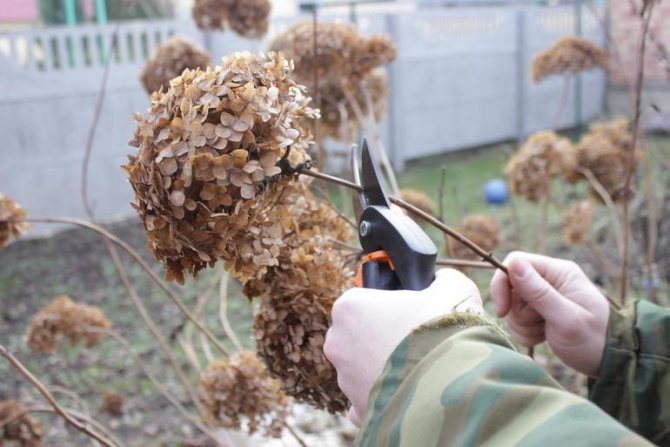

Large-leaved species
This garden hydrangea forms inflorescences on second year stems. Such shoots must be preserved for the winter. With the onset of autumn, a cosmetic trimming of the bush is carried out, weakened, diseased and damaged branches and faded brushes are removed. It is also better to remove old shoots in the lower part. After wintering, young twigs are carefully examined. The stems affected by frost are cut off. Large-leaved plant species often form young shoots on zero shoots, but they never have inflorescences on them.
The principles of autumn pruning are as follows:
- Shoots are removed immediately after the end of flowering. In this case, young twigs are formed on the bushes even before the onset of cold weather.
- All stems directed towards the inside of the bush are carefully cut out.
- Some of the old shoots are removed every 3 years. This rejuvenates the large-leaved hydrangea and stimulates flowering.
- Before the onset of winter, diseased and damaged shoots are cut off.
The intensity of pruning directly depends on the region in which the large-leaved hydrangea is grown. If the climate in a particular area is warm and the summer is long, the processing can be done deeper.
Advice!
This is allowed in the Kuban, southern regions and central Russia. In Siberia and the Urals, it is enough to do a superficial procedure.
The need for a procedure
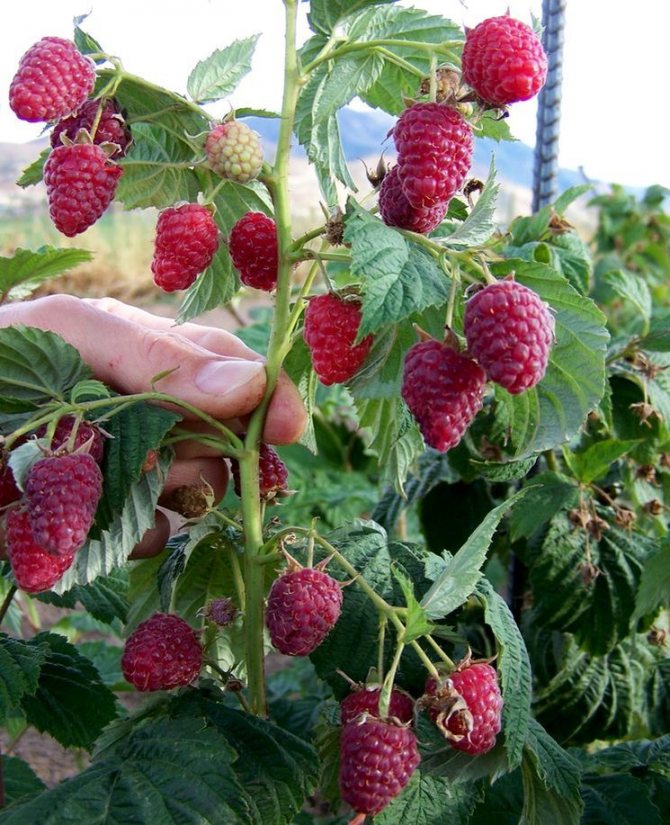

From the aesthetic point of view, a pruned plant looks much better, and most importantly, such actions increase the likelihood of lush flowering for the next season. Already when the bush unfolds after the winter period, you can see how it has changed, especially if it was standing in greenhouse conditions, here full-fledged buds can already form.
For hydrangeas, autumn pruning is extremely useful, it cleans, gives an impetus to circulation in other parts of the bush, the shoots will not break or freeze, and in the spring you will not have to trim all the shoots again. Before you cover the hydrangea, you need to feed it well, using care according to the type of bush, then in covered conditions they will begin to be absorbed much better. If the pruning is done correctly and accurately, the hydrangea will bloom wonderfully next year.
The nuances of plant care after pruning
After pruning in the spring, the plant needs proper care.First of all, the cut must be fed. This will stimulate the rapid growth of young and strong shoots ready to bloom. It is better to give preference to mineral fertilizers. The second step after feeding the plant is to fertilize the soil. This action will reduce the growth of weeds, accelerate root growth, and protect the plant from pests. The fertilizer layer should be at least 5 cm. The next step for the plant is abundant watering. It is he who will provide lush growth, a luxurious crown and lush flowers. Young branches must be tied up, otherwise the flowers that appear can break them.
Characteristics of the genus


Hydrangea is a plant that belongs to the Hortensia family and consists of approximately 70–80 species. Most of them live in East Asia. Shrubs grow up to 3 meters and are considered the most common representatives of their kind, others look like small trees, and all the rest are vines that twist along the trunks and reach a height of up to 30 meters. Plants are both deciduous and evergreen. Often it is the first species that are cultivated.
Flowering begins in the spring and lasts until late autumn. At the end of the stem, the flowers are collected in spherical inflorescences, have a corymbose or paniculate shape.
In most varieties, there are heads, in which 2 types of flowers are collected, in the middle are small and fruiting, and at the edges are large, but sterile. And you can also find plants in which all the links are the same and are considered fertile. The bloom color will depend on the species. White is the most common and can be seen in blues, pinks, lilacs, reds and yellows.
Shelter construction
When constructing a shelter, you need to take into account the type of hydrangea, the size of the bush and its age. For an adult shrub, you can limit yourself to hilling; snow will play the role of additional insulation here. In young specimens, it is still better to cover the shoots. Features of covering measures for each type of plant will be as follows:
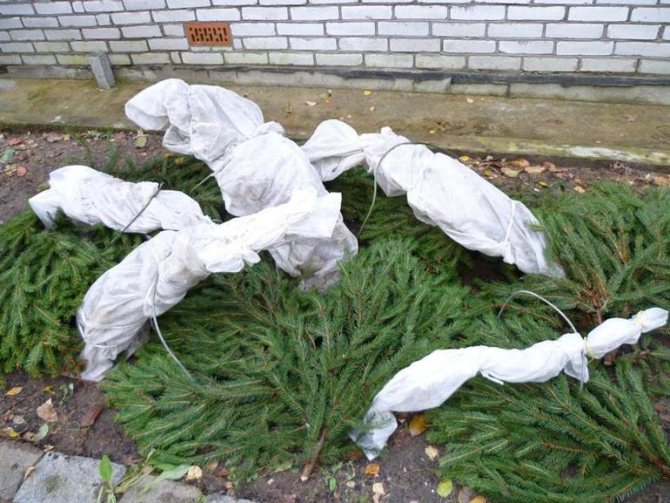

- In panicle hydrangea, the most viable buds are formed in the middle part of the shoots, so freezing the tops of the branches will not cause much harm to the plant. When constructing a shelter for her, you need to take into account the weather characteristics of the region. It is not only frost that can play a negative role. In strong and humid winds, the bush can suffer much more. In the southern regions and the middle lane for panicle hydrangea, there will be a sufficiently high hilling with a mixture of dry soil and peat. In Siberia and the Urals, branches are bent in the ground and fixed by throwing spruce branches, burlap or agrofibre on top. Large bushes are wrapped in a vertical position with several layers of non-woven covering material.
- For a thermophilic large-leaved hydrangea, a shelter must be made in advance, without waiting for the arrival of sub-zero temperatures. Before covering the plant, the leaves are cut off from it, leaving them only at the very top to protect the apical buds. After that, the bush is divided in half, bending each part to the ground and installing metal arcs over the branches. Then the hydrangea is mulched with peat or pine needles. On top of the arc, you need to cover it with two layers of lutrasil, securing it near the ground. You should not use a film for covering, for the reason that it does not allow air to pass through. It is possible to release the bush in the spring only after the frost has disappeared.
- Treelike hydrangea is a strong and unpretentious plant that requires a minimum of recovery time in the spring. With age, the winter hardiness of the culture increases, but in order to prevent it, it is better to cover it. It is imperative to huddle the roots. The aboveground part is insulated in an upright position, after having tied the shoots to the peg. Spruce branches are laid on top around the plant. In the northern regions, the aerial part is additionally covered with two or three layers of spunbond or lutrasil.You can fasten the material to the plant with a rope. For large and old bushes, a frame shelter is built, filling it with dry foliage inside. In this case, the upper part of the structure will need to be protected from moisture penetration.
Adequate shelter will allow hydrangeas to successfully overwinter while remaining strong and healthy. With insufficient insulation, the bush will not die, but you will not have to wait for abundant flowering from it. Usually the tops of the shoots, on which flower buds are laid, are frozen over. In the spring, the covering material cannot be removed abruptly, at first it is only slightly opened during the thaw. It is finally recommended to remove the shelter when the snow begins to actively melt.
Photo
A lover of garden shrubs, who once saw a blooming hydrangea, will certainly ask the question: how to get this beautiful plant on your site. Read our experts' tips for breeding and planting hydrangeas.
Garden hydrangea
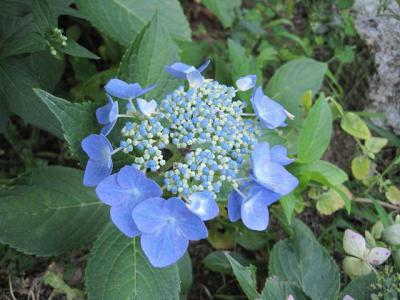

This species blooms on the upper branches of last year's growth. It is considered important information for beginners, pruning hydrangeas in the fall of these varieties is not carried out, it is recommended only to clean out their lower part. To do this, you need to rely on the following rules:
- all dried inflorescences must be removed as they appear - this will make it possible for new branches to grow;
- if the flowering is plentiful, only part of the young shoots that are formed in the depths of the bush are cut;
- overly diseased and old branches must be removed completely.
It is important to know that the milder the climate, the more careful pruning is required. In such cold regions as the Urals, Siberia and the Northwest, garden hydrangea is cut to a minimum.
And also for all types there is another type of pruning - rejuvenation, intended for those specimens that are more than 7 years old. Everything is carried out the same way, shoots are cut to a height of 10-15 cm. With minimal intervention, it is recommended to leave literally a few strong branches growing outward.
The most common mistakes
Pruning hydrangeas in the fall can be a bit tricky for beginners. In this regard, many gardeners make mistakes. The most common of them are:
- Pruning the hydrangea bush in the first 2 years after planting the cuttings. During this time, the plant should gain strength, build up green mass, and develop healthy roots.
- Removal of shoots in close proximity to the buds. As a result of such actions, the hydrangea bush may dry out.
If all steps were taken correctly, hydrangea will delight with bright and lush flowers for many years.
Bush or tree
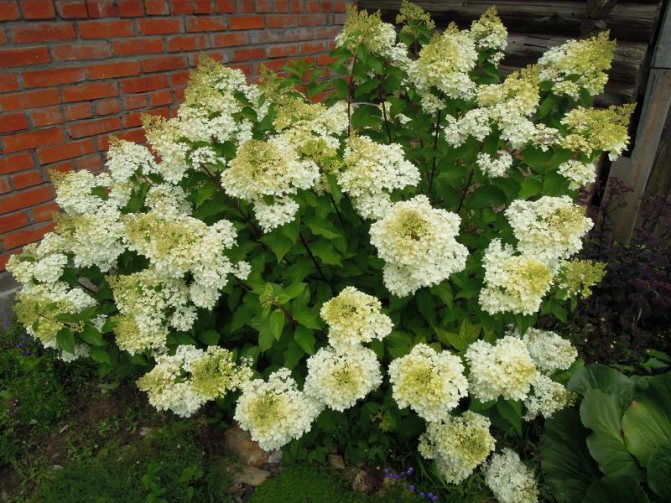

Hydrangea Vanilla Fries
In gardens, panicle hydrangea is grown in the form of a bush or tree. To give the plant a bushy shape from the second year, all shoots are cut over 3 buds. This is done in such a way that the last upper bud looks outward, then the bush will grow on the sides, and not inward. Such pruning in Central Russia, including the Moscow region, takes place in the autumn, and in cold regions, for example, the Leningrad region, forming pruning is done in the spring.
The following varieties are popular among gardeners:
- Vanille Fraise, the bush can grow up to 2 m. It has large whitish-crimson inflorescences reminiscent of lilacs.
- Diamant Rouge has a compact shape. Large (up to 40 cm) inflorescences are first white, then turn red, and the leaves turn orange in autumn.
- Phantom has a powerful sprawling bush with conical white inflorescences cut from above.
- Bobo dwarf variety with abundant and long flowering. Can be grown in containers.


Panicle hydrangea in the form of a tree
To grow hydrangeas in the form of a tree, according to the rules, all shoots are cut off, except one. It needs to be tied to a support. In the spring, the tree will grow side branches, but they need to be pinched.Later, at a height of 1-1.5 m, they begin to lay a crown, for which they eliminate the main trunk and develop the lateral ones. Depending on the variety, either an erect table or a semblance of a weeping willow with bent branches is formed. From 4–5 years in the fall, it is required to remove only weak and diseased stems, extra branches, shoots growing from the root.
For the formation of a tree with an upright crown, the following varieties of hydrangeas are best suited:
- Kyushu with large white inflorescences;
- tardiva with narrow cone-shaped inflorescences of a white-cream shade, gradually turning into pink over time.
For the likeness of "weeping willow" take varieties:
- limelight "(Limelight) with inflorescences of a greenish tint;
- grandiflora with white-cream inflorescences and adult drooping shoots.
The main purpose of the autumn pruning of plants of the first year is the thinning of the bush and the removal of diseased, broken shoots. For old bushes, a rejuvenation procedure is desirable, when the stems are removed almost completely, only low stumps (8-10 cm) remain. If the hydrangea is very ancient and overgrown, then the removal of old shoots is stretched for several years so that the plant does not die from stress and lack of nutrients. After rejuvenation, the plant rests for a whole year, and blooms only in the next season.
Panicle hydrangea
Such varieties are good because they can be used to make both a spreading shrub and a standard crown or a "bouquet on a branch".


The main part of the work is carried out in the spring, then, in addition to the formation of the crown, frozen, damaged and dried branches are necessarily removed. These varieties give flowers only on young shoots, so all procedures must be carried out before the juice begins to move and the buds open. The best time is March or April. The more the shoots are cut, the larger the inflorescences will become. In spring, the branches removed can be used as planting material. To do this, you need to choose the optimal time, the kidneys should already swell a little on them.
The following information is suitable for beginners, pruning hydrangeas in the fall is carried out carefully, since the plant has fragile wood, so it is necessary to remove only dried inflorescences to the buds. Accumulation of winter snow often causes branches to break or bend to the ground.
Tree varieties


The rejuvenation technique is similar to paniculate species. For the first few years, only sanitary cleaning is performed. Pruning hydrangeas in a tree-like fall for beginners will not be difficult, since only the removal of dried flowers is performed. These varieties, like the paniculate varieties, develop peduncles on new shoots that grow back, therefore, it is required to carry out a deep cutting of the plant in order to stimulate the active formation of the crown. This species produces many shoots growing from the root zone. In spring, they are often used for grafting. Three types of trimming are most commonly used:
- Minimal - shortening is done by several buds. In this variant, the hydrangea is cultivated as a free-growing shrub. Flowers grow small, but there are a lot of them.
- Pruning "for flowering" - a few internodes are left on the branches below. In this case, large, but rare inflorescences are formed.
- Full "under the stump" - performed to rejuvenate the plant. It is done only for representatives over 5-7 years old. The branches are cut off 10-15 cm from the ground. Hydrangeas, which for 10 years have not been recommended to be subjected to such a test, as they may die due to lack of nutrition.
Specificity for different species
Gardeners distinguish two main groups of hydrangeas:
- The first one includes those varieties that bloom on shoots formed since last year. Such a group, for example, includes oak-leaved, serrate, large-leaved and liana-shaped hydrangeas.
- The second group includes varieties blooming on new (this year) shoots.
This should include paniculate, tree-like varieties.
Each of the varieties has its own peculiarity of crown formation. Pruning schemes for the most popular varieties should be indicated.
Instructions for pruning a tree hydrangea
- Removing inflorescences.
- Sanitary cleaning - removal of broken and frozen ends.
- Thinning is the removal of zero level shoots that are no longer able to bloom.
- Rejuvenation - the most complete removal of old shoots.
- Cutting for flowering - reducing last year's shoots (by about 3-4 pairs of buds).
Scheme for panicle hydrangea
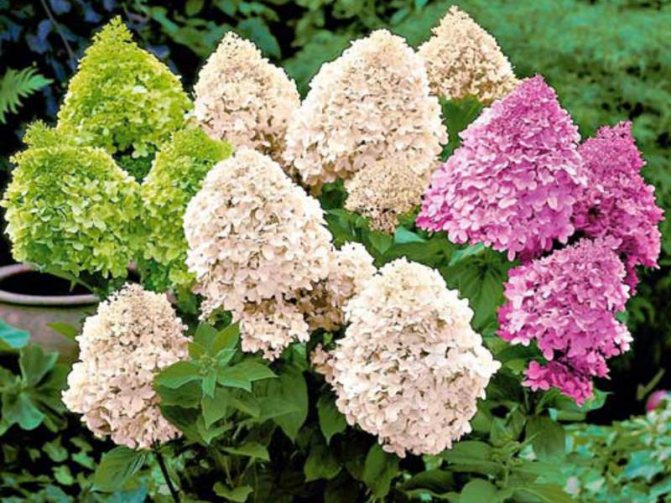

Panicle hydrangea
- Complete removal of conical inflorescences.
- Sanitary cleaning - you only need to get rid of dried particles of shoots (this variety is frost-resistant, therefore, it does not have frozen shoots).
- Trimming strong shoots to increase additional young ones.
- Rejuvenation - you need to get rid of those branches that no longer grow in length.
- Vacuum - you need to remove unnecessary shoots that make the bush sloppy and too overgrown.
Large-leaved hydrangea haircuts
- Removal of faded shoots that are more than two years old. You need to leave new shoots that have not yet given color.
- Sanitary cleaning - complete removal of frozen, dead and damaged branch-branches.
- Rejuvenation - removal of perennial parts.
- Depression - removal of weak and small processes.
What tools are needed to trim
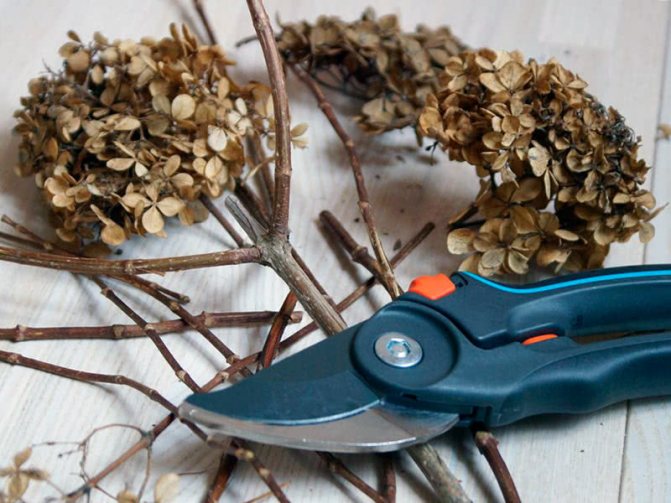

The choice of the tool must be treated carefully so as not to injure the plant with an incorrectly selected pruner
For all types of pruning, it is enough to use a regular garden pruner or garden shears. The choice of these tools depends on the height and variety of the hydrangea. Instruments are disinfected before use. For this, a solution of potassium permanganate is suitable. Before pruning each new bush, the tool is dipped into a disinfecting solution so that infection with pathogenic microbes does not occur.
Why prune?
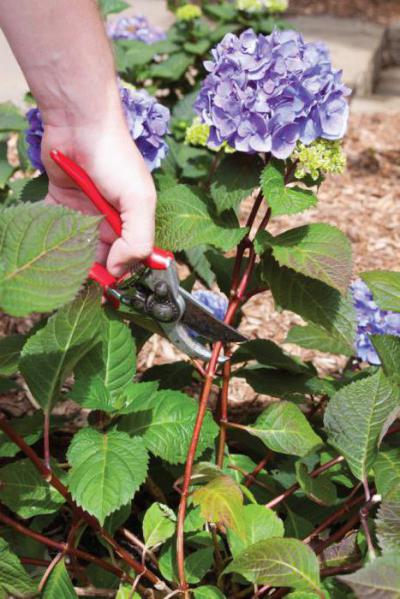

The volume and method of pruning depends on the varietal and species characteristics of the plant. This procedure may not be done at all, but then the foliage will become too thick, and the inflorescences after each year will be smaller and smaller, as a result, the bush will form untidy.
For beginners, you need to know that pruning hydrangeas in the fall is carried out for the following purposes:
- the formation of larger inflorescences;
- formation of the required crown for landscaping a decorative site;
- prevention of breakdowns from the load of snow in the winter;
- removal of weak and old branches;
- "Rejuvenation" of the bush.
Basically all species, with the exception of large-leaved and ground cover hydrangeas, are pruned in the same way as paniculate ones.
At the end of the procedure, the flowers are necessarily fed with fertilizers, and mulching of the root zone is also formed. To do this, it is best to choose a layer of compost or humus 5–7 cm thick. Top dressing will actively stimulate the formation of fresh shoots and growth.
Features of autumn pruning of a plant, depending on the species
To prune a hydrangea, you will need the following tools:
- secateurs (for removing branches up to 2.5 cm thick);
- garden shears (for cutting off shoots up to 1.5 cm in diameter);
- saws or brush cutters (for cutting off thick trunks that are removed only during anti-aging pruning).
Before starting the procedure, garden tools must be disinfected so as not to infect fresh plant wounds. To do this, their cutting part must be treated with either medical alcohol or a dark solution of potassium permanganate.
When trimming, it is important to cut correctly:
- it should run at an angle of 45 degrees to the direction of shoot growth;
- you need to cut in the direction from top to bottom from the leaf bud.
- the upper cut point should be about 5 mm above the kidney.
The general rules for cutting hydrangea shoots are illustrated in the picture below.
If you make a cut at a large angle, then the cut area will increase 2-3 times. This can cause the shoot to dry out from excessive evaporation of moisture through the area. If the cut is made too close to the leaf bud, then during the tightening of the wound, it can dry out and die. If you cut the branch too far from the bud, the wound will heal for too long. And the more it remains fresh, the higher the risk of infection through it. This, again, can cause the death of the shoot and even the entire bush. In this regard, after each pruning, it is necessary to spray the plant with a solution of a drug with an antifungal effect (from the group of fungicides).
There are three main types of hydrangeas grown in the garden:
These plants differ not only in appearance, but also in the peculiarities of flowering. Therefore, the autumn pruning for each variety should be special. Let's find out how to properly cut a hydrangea, depending on its type.


